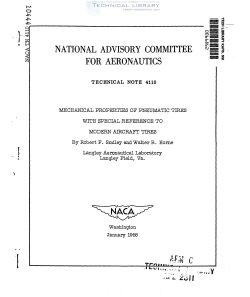naca-tn-4110
- Version
- 172 Downloads
- 5.39 MB File Size
- 1 File Count
- February 4, 2017 Create Date
- February 4, 2017 Last Updated
National Advisory Committee for Aeronautics, Technical Notes - Mechanical Properties of Pneumatic Tires with Special Reference to Modern Aircraft Tires

A study is presented of most of the properties of pneumatic tires
which are of interest to aircraft designers. The principal topics
discussed are tire vertical—force-deflection characteristics; lateral,
fore-and—aft, and torsional spring constants; footprint-area properties;
relaxation lengths; rolling radius; cornering force, cornering power,
self-alining torque, and pneumatic caster for yawed rolling conditions;
effects of wheel tilt; and tire radial growth under the influence of
centrifugal forces.
For each tire property considered, semiempirical equations are set
up which take into account the major factors pertinent to the property.
Wherever possible each equation is compared with the available experi-
mental data to establish its degree of reliability.
A small amount of previously unpublished experimental data is
included, mostly on the subjects of tire tilt, fore—and—aft stiffness,
and centrifugal growth.
In order to cope adequately with the landing and taxiing problems
of present-day aircraft, those engaged in landing-gear design need
information on a large number of pneumatic-tire properties. At present
some information can be Obtained from such sources as references 1 to 63
for a number of obsolete or foreign types of tires and for a few modern
American tires. However, it is doubtful whether the landing-gear
designer will find in the literature experimental data which are directly
pertinent to the particular tire or tires in which he is interested.
moreover, the scale laws which tire properties obey have not been
thoroughly investigated, and, for at least a few important tire properties,
these scale laws are not at all obvious; in some cases, simple and accu-
rate scale laws apparently cannot be established at all. Consequently,
the aircraft designer cannot confidently scale the results of tire tests
in order to apply them to tires in which he is interested.
| File | Action |
|---|---|
| naca-tn-4110 Mechanical Properties of Pneumatic Tires with Special Reference to Modern Aircraft Tires.pdf | Download |
Comment On This Post